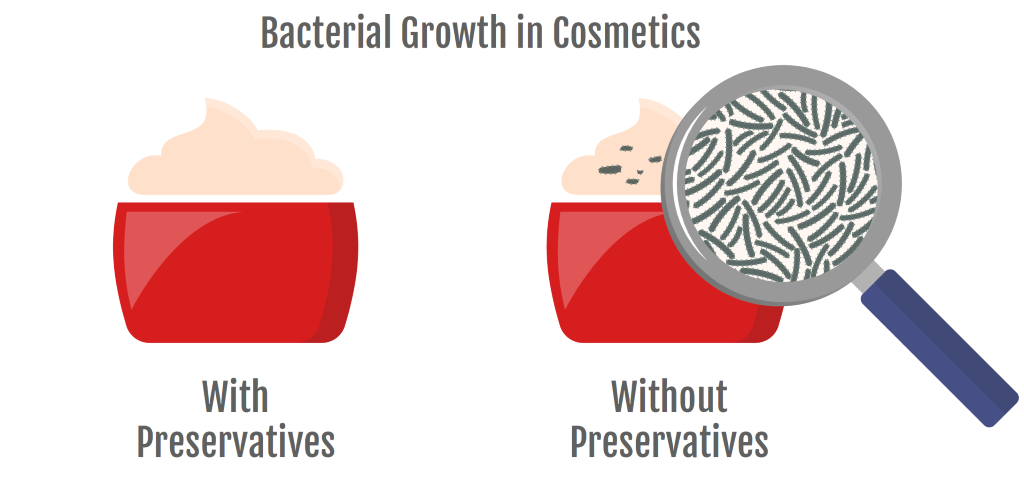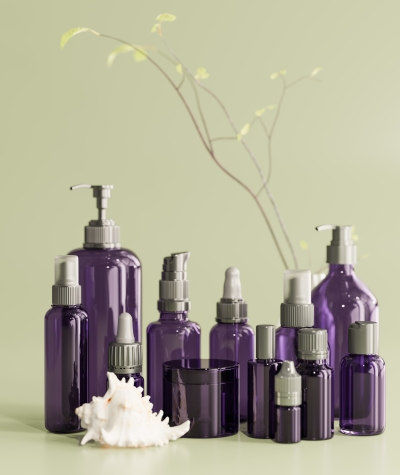In this section:
- Why do we need preservatives?
- Do all products need preservatives?
- Are preservatives safe?
- Shelf-life of cosmetic products
- Useful tips for storage and use of cosmetic products
- How do I know if I need to throw something away?
- Refillable packaging
Why do we need preservatives?
Product safety is the number one priority for the cosmetics industry, and so each product has been carefully created to prevent contamination by microorganisms, which are bugs such as bacteria, yeasts or mould. Bacteria, yeasts and moulds are always present on our skin, in the air around us and even in the water we drink. These can get into products during normal use. Contamination of products, especially those used around the eyes and on skin, can cause significant problems if the level of contamination is high. Preservatives can prevent these problems by stopping micro-organisms from multiplying in the product.

Source: The ICCR
Watch a short Preservatives Film Clip to see why preservatives are so important.
The European Commission infographic also emphasises the importance of preservatives for cosmetic products.
Do all products need preservatives?
Not all cosmetic products need preservatives. Usually products that contain water, such as moisturisers, shampoos or make-up need preservatives.
Products that do not usually require preservation include:
- Water-free (anhydrous) products such as body oils and oil-based hair serums.
- Products which are more acidic, such as antiperspirants, or more alkaline, such as depilatory (hair-removal) creams. These acidic or alkaline environments are less friendly for microorganisms to grow in.
- Products with a high alcohol content, generally 20% or above, such as perfumes and after shaves.
- Aerosol products with airtight packaging. This packaging prevents contact with the air; for example, aerosol hair sprays.
Are preservatives safe?
The use of preservatives is sometimes questioned because some people are unfortunately allergic to certain preservatives or can experience skin irritation after using products containing them. Having an allergy, or sensitive skin, can be very unpleasant. Cosmetic products are subject to strict UK safety rules to ensure that they don't pose a health risk. Safety assessments include allergy safety, which greatly minimises the risk of products causing adverse reactions.
Therefore, it's not that ingredients in these are unsafe it's the way the body reacts to them can differ from person to person. Preservatives play an essential role in ensuring the safety of cosmetics by keeping them safe for use during the normal life of the product.
Shelf-life of cosmetic products
Once opened, cosmetic products become exposed to dirt and microorganisms (bacteria, yeasts and moulds) that are found in the air, on the skin and on applicators and brushes. Microorganisms can get into products where they may be able live and grow.
If a product has a limited shelf life (less than 30 months - two and a half years) it is required to be labelled with a 'best before' date. "Best before" dating is uncommon as most cosmetic products are formulated to ensure they have a long shelf life.
Durable cosmetics, those with a shelf life of at least 30 months, are in the majority. Even so, some consumers want to know how long an opened product can be kept.
A symbol introduced by the industry in conjunction with the authorities recommends the length of time a product remains useable after opening. This period is referred to as the 'period after opening' (PAO). The period is given as a number of months and is marked with a letter 'M' under or within the 'open jar' symbol. When a PAO symbol is required this will appear on the product itself and on the outside packaging.

In practice, most cosmetic and personal care products are formulated to ensure that they are safe to use and have a shelf-life which far exceeds the normal time it would take to use the product up.
Useful tips for storage and use of cosmetic products
- Always read the instructions carefully; including any warnings for use.
- Keep lids on products when not in use and use the product within the recommended time.
- Avoid storing your products in the direct sunlight or near sources of heat and choose dry, cool (but not freezing) storage areas where possible.
- Never dilute products or mix with other products (unless directed to do so by the product instructions).
- Apply cosmetics with clean hands or an applicator and routinely wash all applicators thoroughly with soap, detergent or a mild shampoo.
- Allow applicators to dry thoroughly before use.
- Avoid sharing your personal cosmetic products with another person.
How do I know if I need to throw something away?
If a product has not been stored properly, for example it has been left with the lid off for long periods of time, the product may 'go off' before either the best before date or the period after opening has passed. It is easy to spot this as these products may be discoloured, smell different or look unusual (lumpy rather than smooth for example). If this is the case, the product should not be used as they will certainly be unpleasant, might not do their job properly or could be a risk to someone whose skin is not healthy; for example, if you have broken or sunburnt skin.
With correct storage and handling, cosmetic products should remain in good condition for their expected life. However, if a product discolours or has an unpleasant smell, it should be discarded since this indicates the product is not as it should be.
Refillable packaging
Many brands are now offering sustainable options in the form of refillable packaging. This may be in the form of a container that you take back to the shop to be refilled or a container that you refill at home from a larger container of the same product. We all know about the importance of storing cosmetics and toiletries properly and that products can easily become contaminated, especially with microorganisms, once containers have been opened. This remains true when containers are refilled with 'fresh' product.
To help protect yourself and your family from any potential contamination or old product that has 'gone off' but is still inside the container, shops or brands might ask you to thoroughly wash, or wash and dry, a container before refilling it. If the instructions advise you to do this, it is extremely important that you follow these instructions carefully.

